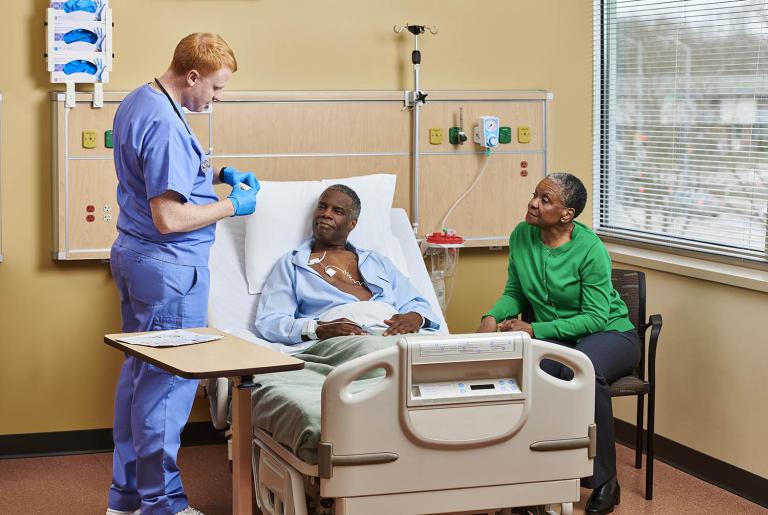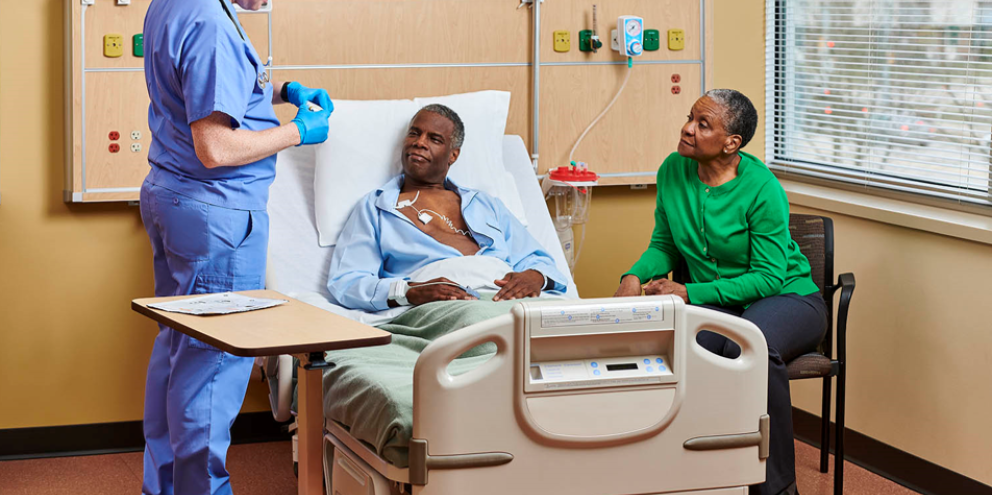
Hospital leaders can lay a foundation for improving patient care by establishing more effective ways for clinical teams to detect patient deterioration as early as possible. That begins with equipping physicians and nurses with tools and information to optimize care. The right continuous monitoring technologies, typically reserved for the ICUs, enable clinicians in general care units to know when to move patients who need it to intensive care units quickly, or confidently discharge people.
The introduction of wireless and wearable monitoring devices is enabling new use cases for lower acuity settings as well, notably medical-surgical units, telemetry, and emergency departments. This article examines the benefits of continuous monitoring within medical-surgical units: improving patient care, reducing cognitive burden on clinicians, and driving economic advantages.
Improving Patient Care
Traditional vital signs monitoring conducted by spot checks, typically every 4-8 hours, can be inconsistent. The intervals between spot checks can create blind spots wherein clinicians can miss vital signs that are abnormal or trending toward abnormal.
In contrast, continuous monitoring can improve patient safety by detecting deterioration earlier, enable timely interventions, prevent adverse health events, or readmissions, and improve clinical outcomes1. One before-after study found that continuous monitoring can help clinicians be more vigilant and result in earlier detection and prompt interventions, including ICU transfers, that lead to lower disease severity when patients are transferred to the ICU2.
A different study that continuously monitored respiratory rate and heart rate on a medical-surgical unit yielded significant decreases in total length of stay and ICU days3. Yet another continuous monitoring initiative decreased ICU utilization, length-of-stay, code blue events, and costs across multiple care units with continuous monitoring4.
Reducing Cognitive Burden on Clinicians
In addition to improving patient care, continuous monitoring in the medical-surgical unit benefits clinicians with actionable data that can reduce alarm fatigue. For example, a Cleveland Clinic initiative (funded by GE HealthCare) measured the respiratory rate, oxygen saturation, and pulse rate of 100 post-surgical patients with continuous monitoring. “The initial average of alarms per patient per day was 7 but, after adjusting thresholds for those patients with >24 alarms per day, the average dropped to 3 per day, or roughly 1 alarm every 8 hours, per patient5.”
Another study determined that continuous monitoring in medical-surgical units can optimize rapid response team notifications in a clinically beneficial manner and reduce failure-to-rescue events6. A different two-year study of wearable continuous vital sign monitoring found the program reduced rapid response team activations (4.3% vs. 3.1%) and unplanned ICU admissions (3.4% vs. 2.3%)7.
Clinicians also indicate they appreciate the benefits of being able to more carefully and comprehensively monitor patients in the medical-surgical unit. Among nurses working with patients who used a continuous monitoring device, 74% reported that data provided by the device enhanced decision-making8. Based on a 2021 clinical study performed at a London hospital in the UK that collected feedback from 27 nurses serving 33 patients in hospital ward settings, 90% of nurses agree they feel more reassured about their patient's condition when continuous monitoring is used9.
Based on a 2021 evaluation clinical study performed at a London hospital in the UK. Collecting feedback from 27 nurses serving 33 patients in hospital ward settings,
Easing the burden on nurses and physicians and making them more confident, in turn, allows them to focus more on the high-quality personalized care they want to deliver to patients.
Driving Economic Advantages
While research illustrates the power of continuous monitoring for improving patient care, reducing alarm fatigue, and empowering clinicians with data for quicker and more accurate decision making, some hospitals and health systems are already finding that continuous monitoring can also be financially advantageous.
An average-sized community hospital that deployed continuous vital sign monitoring to 100% of patients in the medical-surgical unit could reduce overall annual costs by an estimated 14% to save approximately $6.8 million10. For that hospital, avoiding serious adverse events that escalate patients to the ICU could result in annual cost-savings of $3.5 million by reducing length of stay11.
Another institution reduced ICU transfer rates to save 367.11 ICU days during a 2-year period. The result? More than $2.3 million in cost savings12.
Evaluating the ROI of continuous monitoring in medical-surgical units found “a highly positive return on investment … [that] may justify the accelerated adoption of this system across remaining inpatient non-ICU wards of the hospital,” according to a different study based on a 5-year ROI model13.
Just as easing the alarm burden on clinicians improves care, reducing costs and deriving ROI from continuous monitoring tools drives the financial sustainability hospitals and health systems need to focus on taking the best possible care of patients.
Conclusion
New wireless and wearable technologies are making continuous monitoring a reality today. U.S. hospitals now have the tools to detect patient deterioration earlier outside ICU settings by continuously tracking respiratory rate, heart rate and SpO2. Earlier detection enables clinicians to take necessary action to avoid adverse health events. Continuous patient monitoring also has been shown to improve patient care, reduce the burden on clinicians, and yield a return on hospital investments.
Sources:
[1] Impact of remote patient monitoring systems on nursing time, healthcare providers, and patient satisfaction in general wards, Cureus https://www.cureus.com/articles/255710-impact-of-remote-patient-monitoring-systems-on-nursing-time-healthcare-providers-and-patient-satisfaction-in-general-wards#!/
[2] The effect of continuous versus periodic vital sign monitoring on disease severity of patients with an unplanned ICU transfer, Journal of Medical Systems
https://link.springer.com/article/10.1007/s10916-023-01934-3
[3] Continuous monitoring in an inpatient medical-surgical unit: a controlled clinical trial, American Journal of Medicine https://pubmed.ncbi.nlm.nih.gov/24342543/
[4] Reducing ICU utilization, length of stay, and cost by optimizing the clinical use of continuous monitoring system technology in the hospital, American Journal of Medicine https://www.sciencedirect.com/science/article/abs/pii/S0002934321006987
[5] GE HealthCare announces study results demonstrating Portrait Mobile continuous monitoring solution performance with patients and care teams in the ward, GE HealthCare
https://www.gehealthcare.com/about/newsroom/press-releases/ge-healthcare-announces-study-results-demonstrating-portrait-mobile-continuous-monitoring-solution-performance-with-patients-and-care-teams-in-the-ward
[6] Continuous monitoring in an inpatient medical-surgical unit: a controlled clinical trial, American Journal of Medicine
https://pubmed.ncbi.nlm.nih.gov/24342543/
[7] Effect of continuous wireless vital sign monitoring on unplanned ICU admissions and rapid response team calls: a before-and-after study, British Journal of Anesthesiology
https://pubmed.ncbi.nlm.nih.gov/35282866/
[8] Continuous physiological monitoring improves patient outcomes, American Journal of Nursing https://pubmed.ncbi.nlm.nih.gov/33755624/
[9] Based on a 2021 evaluation clinical study performed at a London hospital in the UK. Twenty-seven nurses from the hospital ward settings used the Portrait Mobile solution with 33 patients. Feedback was collected through a structured questionnaire. Refer to the Evaluation Clinical Study Of The Ambulatory Monitoring Solution (AMS) ME Study Report (DOC2599845) for details.
[10] Cost savings through continuous vital sign monitoring in the medical-surgical unit, Journal of Medical Economics https://www.tandfonline.com/doi/full/10.1080/13696998.2023.2219156
[11] Cost savings through continuous vital sign monitoring in the medical-surgical unit, Journal of Medical Economics https://www.tandfonline.com/doi/full/10.1080/13696998.2023.2219156
[12] Reducing ICU utilization, length of stay, and cost by optimizing the clinical use of continuous monitoring system technology in the hospital, American Journal of Medicine https://www.sciencedirect.com/science/article/abs/pii/S0002934321006987
[13] The return on investment of implementing a continuous monitoring system in general medical-surgical units,Critical Care Medicine https://pubmed.ncbi.nlm.nih.gov/24717454/







